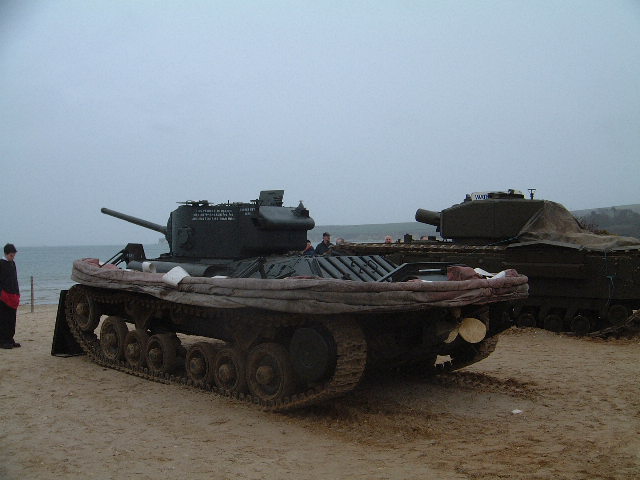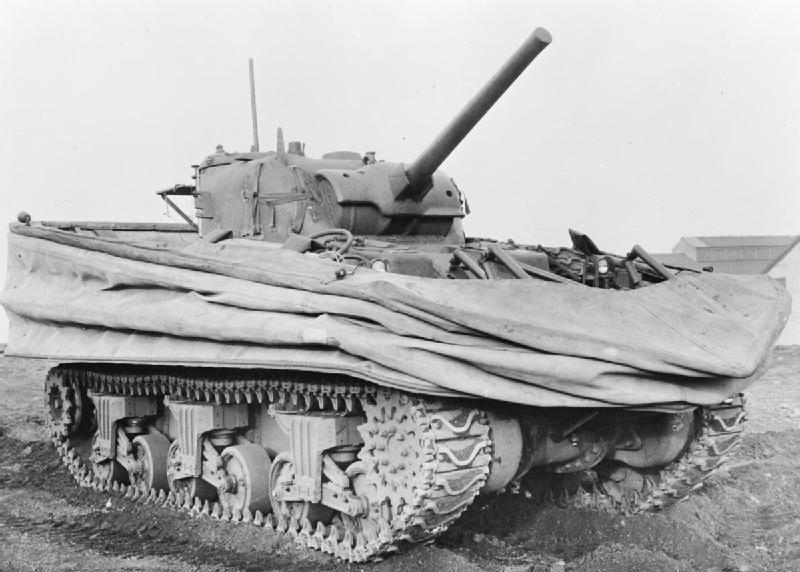

"One of the most secret and startling devices" that had yet been evolved.

Although General Hobart could not reveal as much, the 4th/7th Royal Dragoon Guards were now committed to the most spectacular and critical operation of the whole war.
At last there was a goal to work for, and with ebbing morale flooding back again the Regiment moved down to a new training area at Fritton, inland from Great Yarmouth, where there was a chain of extensive waterways and lakes. The significance of these became apparent simultaneously with the revelation of the "secret device" promised by the Divisional Commander: the tanks were to become amphibious.
Flotation was achieved by means of a collapsible canvas screen fitted to the tank's hull just above the running gear. When erected, by compressed air, the screen was held taut by struts and compressed air tubes, and enveloped the vehicle completely above the tracks. The watertight canvas walls provided extra displacement to discount the total weight of the tank and thus enabled it to float. On landing, the screen could be instantly collapsed by a quick-release device, and the tank was ready for action. At first there were some ribald comments about the curious appearance of the "swimming tank" with its screen erected ashore - it looked like a mobile field latrine - but when afloat with only about three feet of the screen showing above the water line it seemed to be transformed into an innocent canvas boat, with no hint of the lethal weapon beneath. Swimming power was provided by small propellers at the stern, which could be engaged and disengaged by the driver, and thus the amphibious vehicle was known as a DD tank (Duplex Drive). Of course this new device had an obvious snag: should the screen be badly damaged "at sea", the tank would assuredly plummet to the bottom, its crew trapped in conditions worse than a "subsmash". Some moral backing for crews was therefore provided, and in addition to rather light-hearted navigational exercises on the Fritton lakes, officers and men of the 4th/7th Dragoon Guards now found themselves subjected to submarine training with the Davis Escape Apparatus and a mock-up tank hull which could be flooded at the bottom of a shaft. Captain Alastair Morrison recalls these horrors:
Clad in wet overalls, down the dripping ladder we would climb, into the turret. A wave and an unseen hand would release a deluge of water, which roared and swirled round the ears. Nose-clips on, breathe out, mouthpiece in, switch on oxygen, and you lived again. Kick the driver: out of his hatch he would vanish; tap the gunner, then the operator. They would float gently past and upwards, followed at last by the Commander (in true Naval tradition).
Initial amphibious training was done with the Valentine tank (Infantry Tank Mark III), but in July 1943 the Regiment at last began to receive the AFVs with which they would fight the rest of die war. These were the American-built Shermans, subsequently acknowledged as the best allied tanks of the war - even though out-gunned and out-armoured by much of the German opposition. If the old Covenanter had seemed a winner after the puny little Mark VI Light, this newcomer was surely a killer: "a most heartening sight" said John Stirling.
In fighting trim the Sherman weighed nearly 32 tons, had a maximum armour thickness of 76mm, and was powered by twin diesel engines which gave it a road speed of about 29 mph. But the most impressive feature was the hard-hitting 75mm gun, stabilised in elevation, and backed up with one coax .30in Browning and another, ball-mounted, in the bow. A third heavy MG was mounted in the turret for anti-aircraft defence, but this was scarcely ever used. There was adequate room for the crew of five: Commander, gunner and operator-loader in the turret, and driver and co-driver (or hull-gunner) forward in the bow. The Sherman boasted all the latest 'mod. cons.' not before seen by the Regiment. The electrically-traversed turret could be swung through 180 degrees in nine seconds flat; the main armament was also electrically controlled and the gunner could fire his weapons merely by treading on a foot-button; each crew member had a rotatable periscope which gave him a good field of view when closed down. The Number 19 wireless set was a vast improvement on the old Number 9, being in fact three sets in one: the main transmitter-receiver was the 'A' set, used for long-range work such as a rear-link contact; the 'B' set was for short-range work - inter-Troop communication and contact with accompanying infantry - while the 'IC', or Intercom, was of course for inter-crew speech.
ball-mounted, in the bow. A third heavy MG was mounted in the turret for anti-aircraft defence, but this was scarcely ever used. There was adequate room for the crew of five: Commander, gunner and operator-loader in the turret, and driver and co-driver (or hull-gunner) forward in the bow. The Sherman boasted all the latest 'mod. cons.' not before seen by the Regiment. The electrically-traversed turret could be swung through 180 degrees in nine seconds flat; the main armament was also electrically controlled and the gunner could fire his weapons merely by treading on a foot-button; each crew member had a rotatable periscope which gave him a good field of view when closed down. The Number 19 wireless set was a vast improvement on the old Number 9, being in fact three sets in one: the main transmitter-receiver was the 'A' set, used for long-range work such as a rear-link contact; the 'B' set was for short-range work - inter-Troop communication and contact with accompanying infantry - while the 'IC', or Intercom, was of course for inter-crew speech.